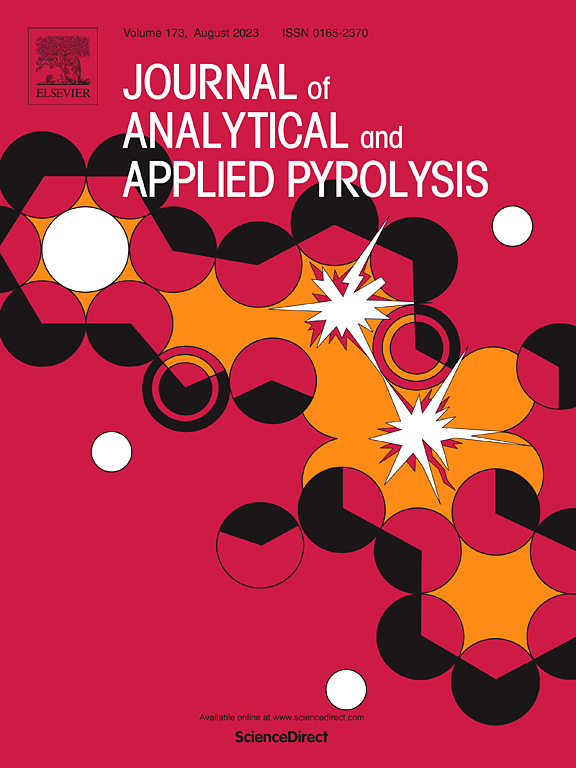Pyrolysis oil upgrading via hydrotreatment to produce alternative fuel using ZrO2-supported catalysts and isopropanol as a solvent
IF 6.2
2区 化学
Q1 CHEMISTRY, ANALYTICAL
引用次数: 0
Abstract
Biomass pyrolysis is a promising approach for sustainable bioenergy production, primarily due to its ability to produce a high amount of liquid. However, the high oxygen content in pyrolysis oil limits its applicability in transportation fuels, necessitating deoxygenation for upgrading. Conventional two-step upgrading processes, involving stabilization and hydrotreatment, can be complex and costly. This study investigates a one-step hydrotreatment of fast pyrolysis bio-oil from pine wood using isopropanol (IPA) as a hydrogen-donating solvent to upgrade pyrolysis oil properties. A comprehensive evaluation was conducted to assess the influence of solvent type (IPA vs. glycerol), hydrogen pressure (500 vs. 1000 psi), and catalyst types (NiMo/ZrO2, CoMo/ZrO2, NiMo/Al2O3, CoMo/Al2O3, Ni/SiO2-Al2O3) on the physicochemical characteristics of the upgraded oil. IPA demonstrated superior performance in increasing carbon content of upgraded oil (from 43.9 % to 68.5 %) and higher heating value (from 17.4 to 31.2 MJ/kg), whereas glycerol promoted greater oxygen removal (up to 89.6 %) under moderate pressure (500 psi) with NiMo/ZrO2. The effect of hydrogen pressure depends on the catalyst type. Among the evaluated catalysts, NiMo/ZrO2 demonstrated superior performance for pyrolysis oil upgrading. Thermogravimetric analysis indicated minimal coke formation on NiMo-based catalysts, particularly with ZrO2 support. Simulated distillation results further emphasized the role of reaction time in maximizing jet fuel-range product yields. Catalyst regeneration experiments confirmed that NiMo/ZrO2 maintains robust deoxygenation activity over three cycles, with only slight deactivation attributed to coke accumulation. This study offers a practical route for efficient one-step pyrolysis oil upgrading using a non-noble catalyst and IPA.
以zro2负载催化剂和异丙醇为溶剂,通过加氢处理热解油升级生产替代燃料
生物质热解是一种很有前途的可持续生物能源生产方法,主要是因为它能够产生大量的液体。但热解油中氧含量高,限制了其在运输燃料中的适用性,需要进行脱氧改造。传统的两步升级工艺包括稳定化和加氢处理,既复杂又昂贵。研究了以异丙醇(IPA)为供氢溶剂对松木快速热解生物油进行一步加氢处理,以改善热解油的性能。综合评价了溶剂类型(IPA vs.甘油)、氢气压力(500 vs. 1000 psi)和催化剂类型(NiMo/ZrO2、CoMo/ZrO2、NiMo/Al2O3、CoMo/Al2O3、Ni/SiO2-Al2O3)对提质油理化特性的影响。IPA在提高升级油含碳量(从43.9 %提高到68.5 %)和更高的热值(从17.4提高到31.2 MJ/kg)方面表现出优异的性能,而甘油在中等压力(500 psi)下与NiMo/ZrO2一起促进了更高的除氧(高达89.6 %)。氢气压力的影响取决于催化剂的类型。在评价的催化剂中,NiMo/ZrO2对热解油的提质效果较好。热重分析表明,在镍基催化剂上,特别是在ZrO2载体上,形成的焦炭很少。模拟蒸馏结果进一步强调了反应时间在最大限度地提高喷气燃料产品收率方面的作用。催化剂再生实验证实,NiMo/ZrO2在三个循环中保持强大的脱氧活性,只有轻微的失活归因于焦炭堆积。本研究为非贵金属催化剂和异丙酸催化一步热解油的高效提质提供了一条实用途径。
本文章由计算机程序翻译,如有差异,请以英文原文为准。
求助全文
约1分钟内获得全文
求助全文
来源期刊
CiteScore
9.10
自引率
11.70%
发文量
340
审稿时长
44 days
期刊介绍:
The Journal of Analytical and Applied Pyrolysis (JAAP) is devoted to the publication of papers dealing with innovative applications of pyrolysis processes, the characterization of products related to pyrolysis reactions, and investigations of reaction mechanism. To be considered by JAAP, a manuscript should present significant progress in these topics. The novelty must be satisfactorily argued in the cover letter. A manuscript with a cover letter to the editor not addressing the novelty is likely to be rejected without review.

 求助内容:
求助内容: 应助结果提醒方式:
应助结果提醒方式:


